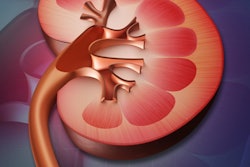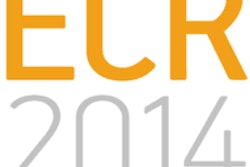
Patients who develop contrast-induced nephropathy (CIN) are at high risk of major adverse events one year after imaging with contrast-enhanced CT, according to a new study in the September Annals of Emergency Medicine. The experience in more than 600 patients who underwent contrast CT suggests the problem is both serious and underrecognized.
Among the patients undergoing contrast-enhanced CT, 11% developed acute kidney injury and 15% experienced a major adverse event within a year, including several deaths, reported Dr. Alice Mitchell and colleagues from Indiana University School of Medicine and two other institutions. Mitchell is an assistant professor of emergency medicine at Indiana University.
"The main finding is that measurable rises in creatinine that are consistent with contrast-induced nephropathy happen more often than previously thought, and there appears to be an association with an increased risk of poor outcomes if that happens," she told AuntMinnie.com in an interview.
Does contrast-enhanced CT cause real harm?
Contrast-induced nephropathy has long been recognized in studies of patients undergoing percutaneous coronary intervention as a source of acute kidney injury and long-term major adverse events. The widespread adoption of iodinated CT contrast has made it a major problem in this modality as well.
Researchers have settled on rising serum creatinine levels as a marker of acute kidney injury, and, indeed, most creatinine measurement now occurs in the setting of inpatient CT exams. But the clinical relevance of CIN after CT remains controversial.
 Dr. Alice Mitchell from Indiana University School of Medicine.
Dr. Alice Mitchell from Indiana University School of Medicine.In the current study, Mitchell and colleagues tested the hypothesis that patients who develop acute kidney injury consistent with CIN after contrast-enhanced CT are at risk of major adverse events within a year after imaging. The investigators followed a group of 633 patients undergoing contrast-enhanced CT for various indications (Ann Emerg Med, September 2015, Vol. 66:3, pp. 267-274).
There was a "greater than twofold increase in the risk of major adverse events within one year for patients who developed acute kidney injury," compared with those who did not, according to the authors. During the year time frame, 11% developed acute kidney injury consistent with CIN and 15% (95 patients) had at least one major adverse event. Among the events, 20 patients (3%) developed severe renal failure, 25 (4%) had acute myocardial infarction, 14 (2%) had a cerebrovascular event, and 46 (7%) died within one year. (Some patients had more than one event.)
Although the association between CT contrast and elevated creatinine levels suggesting acute kidney injury is clear, there are issues that prevent the formation of solid conclusions from this study alone, the authors explained. First and foremost is the question of when elevated creatinine actually means there is acute kidney injury, and the precise role of iodinated contrast in its development is also unclear.
About half of the patients were discharged from the emergency department on the day of enrollment, and another 22% were discharged to the outpatient setting within two days of contrast exposure, "underscoring the challenge of identifying acute kidney injury consistent with contrast-induced nephropathy in the outpatient ambulatory population," they wrote. So although it's clear more research is needed, designing that research is difficult.
The study model necessarily ignores important variables that might explain morbidity and mortality, the authors noted.
"It seems likely that there is an unmeasured confounder that both explains why a patient might develop an elevation in their creatinine level after a contrast-enhanced CT and also might be at greater risk for major adverse events in the following year, namely, in some way the patients are sicker and thus more predisposed to both acute kidney injury and the major adverse events," they wrote.
The issue cannot be easily resolved with an observational study. The current study, for example, could not randomize two groups of patients undergoing CT because those who have CT with contrast and without contrast are two very different cohorts, Mitchell said. What the researchers did do was compare a heterogeneous group of patients who underwent contrast-enhanced CT with patients who underwent invasive coronary angiography, who presumably had more heart disease and did have higher rates of hypertension and other risk factors. Catheterization data are relatively easy to get.
"They all see a cardiologist, they all have follow-up, but it's not the most common procedure," Mitchell said.
Only about 2 million patients a year undergo invasive angiography, versus about 70 million CT scans. More-similar groups of patients are needed for comparison in future studies.
Editorial agrees on challenges
In an accompanying editorial (pp. 275-276), Dr. Richelle Cooper from the University of California, Los Angeles (UCLA) listed key questions that need to be answered before a link can be established between contrast use, creatinine levels, and adverse events, including the following:
- When is a change in creatinine level after contrast simply a random fluctuation, and when does it indicate true renal impairment?
- When there is true renal impairment, how often is it clinically important, and how often does it lead to severe long-term adverse outcomes?
- When there is apparent renal injury after contrast, are there other factors that could cause it?
"Creatinine is an insensitive marker of a moving target," agreed Mitchell. "So if I'm relying on creatinine to tell me who is at risk of acute kidney injury, I think that's pretty outdated. The problem is we don't have an alternative, and why would we change what we do unless there is an outcome problem? If you have a change in a laboratory measurement, who cares? What matters is, do people get sick because of it?"
One problem Mitchell said can be solved going forward is the issue of randomizing two very similar groups of patients; ideas are being lined up for a future study she hopes to announce soon. And each successive study will help clarify the role of iodinated contrast in subsequent adverse events. Even turf plays a role in the wide-ranging controversy about the cause of acute kidney injury, she said.
"The nephrology literature by and large says that contrast-induced nephropathy is a key cause -- that it ranks in the top 10 causes of acute kidney injury, at least in hospitalized patients," Mitchell said. But "the radiology literature says we're not sure it really exists."
Therefore, as the editorial notes, the true goal "is to define the circumstances in which the benefits of contrast-enhanced CT outweigh the risks of harm," Cooper wrote. "This may be accomplished even though questions about nephropathy and whether there is any association with nonrenal major adverse events in the following year remain unanswered."
"There is a big difference between a transient bump in the creatinine level, permanent kidney injury, renal failure, and a shorter and less comfortable life," Cooper continued. "Clearly, there is still a long way to go in determining how contrast imaging affects overall outcomes and the lives of the recipients."



















